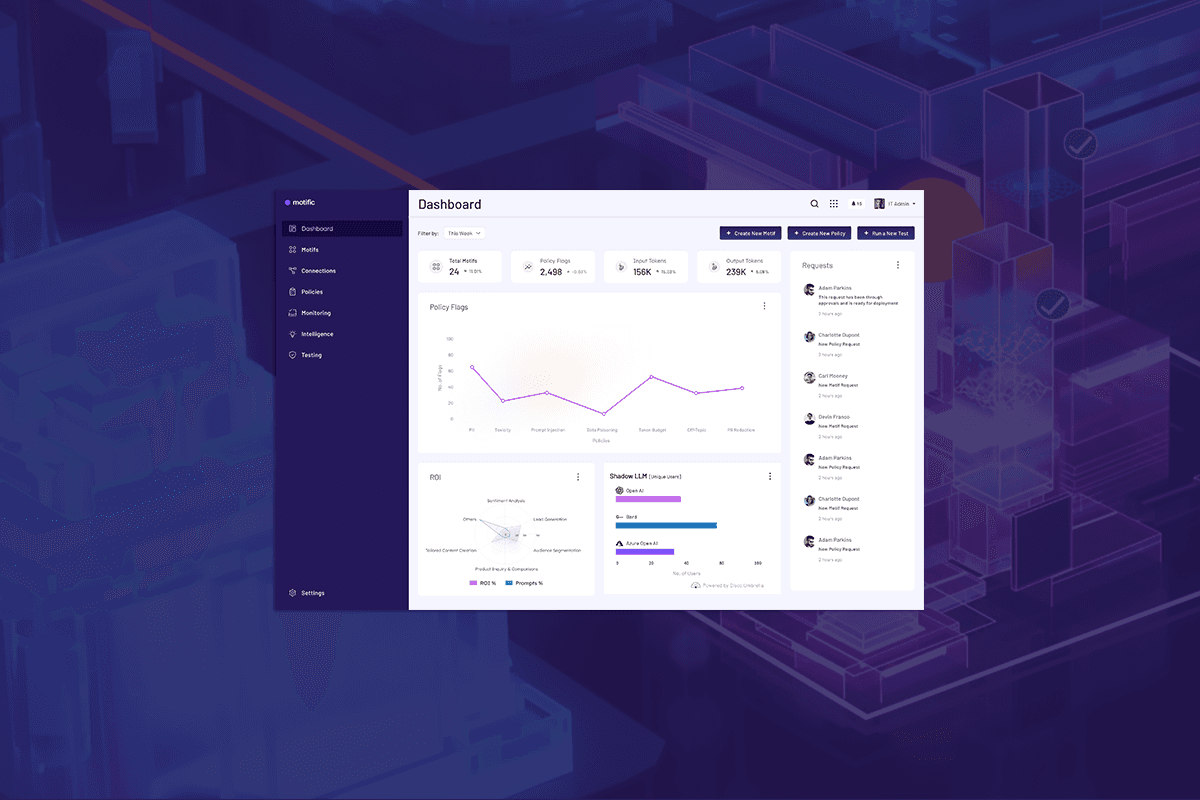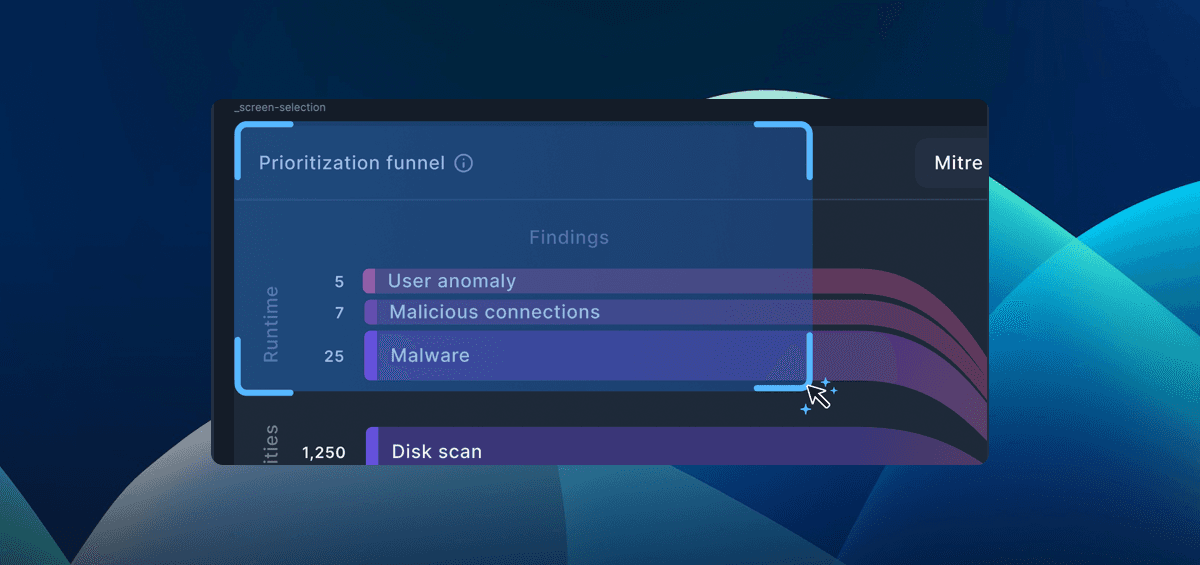Designing for the Unknown:
Designing for the Unknown:
Designing for the Unknown:
Motific Platform - Unlocking Trusted GenAI Adoption for Enterprise Customers
Motific Platform - Unlocking Trusted GenAI Adoption for Enterprise Customers
Motific Platform - Unlocking Trusted GenAI Adoption for Enterprise Customers
At Outshift by Cisco, we embarked on a transformative journey to develop Motific, a platform engineered to accelerate and secure Generative AI deployments.
Projects
·
3 min



Motific is designed to empower IT Admins, Data Scientists and Developers to deploy powerful, secure AI applications while securely leveraging existing organizational data sources and maintaining rigorous policy controls for compliance.
So, that gives us a world where AI agents can discover and authenticate one another, share complex information securely, and adapt to uncertainty while collaborating across different domains. And users will be working with agents that will pursue complex goals with limited direct supervision, acting autonomously on behalf of them.
As a design team, we are actively shaping how we navigate this transformation. And one key question keeps emerging: How do we design AI experiences that empower human-machine teams, rather than just automate them?
The Agentic Teammate: Enhancing Knowledge Work
In this new world, AI agents become our teammates, offering powerful capabilities:
Knowledge Synthesis: Agents aggregate and analyze data from multiple sources, offering fresh perspectives on problems.
Scenario Simulation: Agents can create hypothetical scenarios and test them in a virtual environment, allowing knowledge workers to experiment and assess risks.
Constructive Feedback: Agents critically evaluate human-proposed solutions, identifying flaws and offering constructive feedback.
Collaboration Orchestration: Agents work with other agents to tackle complex problems, acting as orchestrators of a broader agentic ecosystem.
So, that gives us a world where AI agents can discover and authenticate one another, share complex information securely, and adapt to uncertainty while collaborating across different domains. And users will be working with agents that will pursue complex goals with limited direct supervision, acting autonomously on behalf of them.
As a design team, we are actively shaping how we navigate this transformation. And one key question keeps emerging: How do we design AI experiences that empower human-machine teams, rather than just automate them?
The Agentic Teammate: Enhancing Knowledge Work
In this new world, AI agents become our teammates, offering powerful capabilities:
Knowledge Synthesis: Agents aggregate and analyze data from multiple sources, offering fresh perspectives on problems.
Scenario Simulation: Agents can create hypothetical scenarios and test them in a virtual environment, allowing knowledge workers to experiment and assess risks.
Constructive Feedback: Agents critically evaluate human-proposed solutions, identifying flaws and offering constructive feedback.
Collaboration Orchestration: Agents work with other agents to tackle complex problems, acting as orchestrators of a broader agentic ecosystem.
Addressing the Challenges: Gaps in Human-Agent Collaboration
All this autonomous help is great, sure – but it's not without its challenges.
Autonomous agents have fundamental gaps that we need to address to ensure successful collaboration:
So, that gives us a world where AI agents can discover and authenticate one another, share complex information securely, and adapt to uncertainty while collaborating across different domains. And users will be working with agents that will pursue complex goals with limited direct supervision, acting autonomously on behalf of them.
As a design team, we are actively shaping how we navigate this transformation. And one key question keeps emerging: How do we design AI experiences that empower human-machine teams, rather than just automate them?
The Agentic Teammate: Enhancing Knowledge Work
In this new world, AI agents become our teammates, offering powerful capabilities:
Knowledge Synthesis: Agents aggregate and analyze data from multiple sources, offering fresh perspectives on problems.
Scenario Simulation: Agents can create hypothetical scenarios and test them in a virtual environment, allowing knowledge workers to experiment and assess risks.
Constructive Feedback: Agents critically evaluate human-proposed solutions, identifying flaws and offering constructive feedback.
Collaboration Orchestration: Agents work with other agents to tackle complex problems, acting as orchestrators of a broader agentic ecosystem.


Empowering Users with Control
Establishing clear boundaries for AI Agents to ensure they operate within a well-defined scope.
Designing Tomorrow's Human-Agent Collaboration At Outshift
These principles are the foundation for building effective partnerships between humans and AI at Outshift.


Building Confidence Through Clarity
Surface AI reasoning, displaying: Confidence Levels, realistic expectations, and the extent of changes to enable informed decision-making.


Always Try To Amplify Human Potential
Actively collaborate through simulations and come to an effective outcome together.


Let Users Stay In Control When It Matters
Easy access to detailed logs and performance metrics for every agent action, enabling the review of decisions, workflows, and ensure compliance. Include clear recovery steps for seamless continuity.


Take It One Interaction at a Time
See agent actions in context and observe agent performance in network improvement.
Addressing the Challenges: Gaps in Human-Agent Collaboration
All this autonomous help is great, sure – but it's not without its challenges.
Autonomous agents have fundamental gaps that we need to address to ensure successful collaboration:
Addressing the Challenges: Gaps in Human-Agent Collaboration
All this autonomous help is great, sure – but it's not without its challenges.
Autonomous agents have fundamental gaps that we need to address to ensure successful collaboration:
The Solution:
Five Design Principles for Human-Agent Collaboration
What to Consider:
Five Design Principles for Human-Agent Collaboration
Put Humans in the Driver's Seat
Users should always have the final say, with clear boundaries and intuitive controls to adjust agent behavior. An example of this is Google Photos' Memories feature which allows users to customize their slideshows and turn the feature off completely.

Make the Invisible Visible
The AI's reasoning and decision-making processes should be transparent and easy to understand, with confidence levels or uncertainty displayed to set realistic expectations. North Face's AI shopping assistant exemplifies this by guiding users through a conversational process and providing clear recommendations.

Ensure Accountability
Ensure Accountability
Anticipate edge cases to provide clear recovery steps, while empowering users to verify and adjust AI outcomes when needed. ServiceNow's Now Assist AI is designed to allow customer support staff to easily verify and adjust AI-generated insights and recommendations.

Collaborate, Don't Just Automate
Prioritize workflows that integrate human and AI capabilities, designing intuitive handoffs to ensure smooth collaboration. Aisera HR Agents demonstrate this by assisting with employee inquiries while escalating complex issues to human HR professionals.

Earn Trust Through Consistency:
Build trust gradually with reliable results in low-risk use cases, making reasoning and actions transparent. ServiceNow's Case Summarization tool is an example of using AI in a low-risk scenario to gradually build user trust in the system's capabilities.

Designing Tomorrow's Human-Agent Collaboration At Outshift
These principles are the foundation for building effective partnerships between humans and AI at Outshift.
As we refine our design principles and push the boundaries of innovation, integrating advanced AI capabilities comes with a critical responsibility. For AI to become a trusted collaborator—rather than just a tool—we must design with transparency, clear guardrails, and a focus on building trust. Ensuring AI agents operate with accountability and adaptability will be key to fostering effective human-agent collaboration. By designing with intention, we can shape a future where AI not only enhances workflows and decision-making but also empowers human potential in ways that are ethical, reliable, and transformative.
Because in the end, the success of AI won’t be measured by its autonomy alone—but by how well it works with us to create something greater than either humans or machines could achieve alone.
Designing Tomorrow's Human-Agent Collaboration At Outshift
These principles are the foundation for building effective partnerships between humans and AI at Outshift.
Empowering Users with Control
Establishing clear boundaries for AI Agents to ensure they operate within a well-defined scope.


Building Confidence Through Clarity
Surface AI reasoning, displaying:
Confidence levels
Realistic Expectations
Extent of changes to enable informed decision-making

Always Try To Amplify Human Potential
Actively collaborate through simulations and come to an effective outcome together.


Let Users Stay In Control When It Matters
Easy access to detailed logs and performance metrics for every agent action, enabling the review of decisions, workflows, and ensure compliance. Include clear recovery steps for seamless continuity.


Take It One Interaction At A Time
See agent actions in context and observe agent performance in network improvement.


As we refine our design principles and push the boundaries of innovation, integrating advanced AI capabilities comes with a critical responsibility. For AI to become a trusted collaborator—rather than just a tool—we must design with transparency, clear guardrails, and a focus on building trust. Ensuring AI agents operate with accountability and adaptability will be key to fostering effective human-agent collaboration. By designing with intention, we can shape a future where AI not only enhances workflows and decision-making but also empowers human potential in ways that are ethical, reliable, and transformative.
Because in the end, the success of AI won’t be measured by its autonomy alone—but by how well it works with us to create something greater than either humans or machines could achieve alone.



Our team took an evidence-based design-led approach, allowing for rapid iteration and continuous feedback and fostering ongoing collaboration across design, product, and engineering teams. We conducted extensive interviews, mapped out valuable touchpoints in managing AI deployments and gained a deep understanding of perspectives, pain points, and challenges.
All of this was crucial to explore this emerging area and innovate both around IT best practices and AI deployment next practices.
Content
Content



We initiated a design discovery process which enabled a systematic exploration and validation of ideas, ensuring each phase, from discovery to release, was grounded in evidence and iterative improvement.
The benefits of our design-led strategy were evident throughout Motific's rapid development.
Early and continuous user engagement, prioritization of learning, and evidence-based decision-making allowed us to evolve rapidly from an initial concept to a market-ready product in less than 10 weeks.
Our approach ensured our solution was both relevant and innovative and aligned with Outshift’s mission of driving innovation through curiosity.
ContentOur approach ensured our solution was both a and innovative and aligned with Outshift’s mission of driving innovation through curiosity.
ContentOur approach ensured our solution was both relevant and innovative and aligned with Outshift’s mission of driving innovation through curiosity.
The idea of a Motif
A Motif is a bundling of the data, user access, policies and model that is then deployed and managed inside Motific. We created the idea of a "Motif" as a cognitive aid to guide the user toward understanding the purpose of their actions and how they relate to the overall system.



Some More

Projects
·
7 min
Designing Human-Machine Interactions in an Autonomous Agent World

Projects
·
7 min
Designing Human-Machine Interactions in an Autonomous Agent World

Projects
·
4 min
AI Lens - Revolutionizing User Interaction with Contextual AI

Projects
·
4 min
AI Lens - Revolutionizing User Interaction with Contextual AI

Thoughts
·
3 min
Mapping User Journeys for Emerging Technology

Thoughts
·
3 min
Mapping User Journeys for Emerging Technology
Follow the Future of Design
No spam, just some good stuff
Follow the Future of Design
No spam, just some good stuff
Follow the Future of Design
No spam, just some good stuff